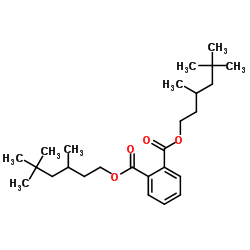UNII:19ND350H65

UNII:19ND350H65 structure
|
Common Name | UNII:19ND350H65 | ||
|---|---|---|---|---|
| CAS Number | 28553-12-0 | Molecular Weight | 418.609 | |
| Density | 1.0±0.1 g/cm3 | Boiling Point | 463.3±18.0 °C at 760 mmHg | |
| Molecular Formula | C26H42O4 | Melting Point | -48ºC | |
| MSDS | USA | Flash Point | 214.9±19.6 °C | |
|
Analysis of phthalates in milk and milk products by liquid chromatography coupled to quadrupole Orbitrap high-resolution mass spectrometry.
J. Chromatogr. A. 1362 , 110-8, (2014) A new analytical method was developed and validated for simultaneous analysis of 27 phthalates in milk and milk products. Response surface methodology was employed to optimize a quick, easy, cheap, effective, rugged, and safe (QuEChERS) sample preparation met... |
|
|
Monitoring and removal of residual phthalate esters and pharmaceuticals in the drinking water of Kaohsiung City, Taiwan.
J. Hazard. Mater. 277 , 53-61, (2014) This study monitored the occurrence and removal efficiencies of 8 phthalate esters (PAEs) and 13 pharmaceuticals present in the drinking water of Kaohsiung City, Taiwan. The simultaneous electrocoagulation and electrofiltration (EC/EF) process was used to rem... |
|
|
Effects of 4-nonylphenol and/or diisononylphthalate on THP-1 cells: impact of endocrine disruptors on human immune system parameters.
Int. J. Immunopathol. Pharmacol. 25(2) , 365-76, (2012) The aim of the present work is to investigate the link between two endocrine disruptor compounds (EDCs), which are chemicals that interfere with the hormone system in human and wildlife, and the human immune response through a study of their effects on the TH... |
|
|
Consumer product in vitro digestion model: Bioaccessibility of contaminants and its application in risk assessment.
Regul Toxicol Pharmacol 44(2) , 161-71, (2006) This paper describes the applicability of in vitro digestion models as a tool for consumer products in (ad hoc) risk assessment. In current risk assessment, oral bioavailability from a specific product is considered to be equal to bioavailability found in tox... |
|
|
Determination of phthalate esters in vegetable oils using direct immersion solid-phase microextraction and fast gas chromatography coupled with triple quadrupole mass spectrometry.
Anal. Chim. Acta 887 , 237-44, (2015) Phthalates are a group of synthetic compounds mainly used as plasticizers, which have been classified as endocrine-disrupting chemicals and potential human-cancer causing agents. They can be found in high amounts in foods, deriving mainly from plastic packagi... |
|
|
Intestinal pregnane X receptor links xenobiotic exposure and hypercholesterolemia.
Mol. Endocrinol. 29 , 765-76, (2015) Recent studies have associated endocrine-disrupting chemical (EDC) exposure with the increased risk of cardiovascular disease in humans, but the underlying mechanisms responsible for these associations remain elusive. Many EDCs have been implicated in activat... |
|
|
Monitoring of PAEMs and beta-agonists in urine for a small group of experimental subjects and PAEs and beta-agonists in drinking water consumed by the same subjects.
J. Hazard. Mater. 277 , 169-79, (2014) This 5-month study contains two parts: (1) to monitor the concentrations of 11 phthalate esters metabolites (PAEMs) and two beta-agonists in human urine samples collected from a small group of consented participants including 16 females and five males; and (2... |
|
|
A dose response study to assess effects after dietary administration of diisononyl phthalate (DINP) in gestation and lactation on male rat sexual development.
Reprod. Toxicol. 35 , 70-80, (2013) Male rat sexual development was evaluated after dietary administration of 0, 760, 3800, 11,400 ppm diisononyl phthalate (DiNP) and 7600 ppm dibutyl phthalate (DBP) from gestation day (GD) 12 to postnatal day (PND) 14. Maternal weight was reduced on GD 20, PND... |
|
|
Occupational exposure to diisononyl phthalate (DiNP) in polyvinyl chloride processing operations.
Int. Arch. Occup. Environ. Health 85(3) , 317-25, (2012) Diisononyl phthalate (DiNP) is primarily used as a plasticizer in polyvinyl chloride (PVC) materials. While information is available on general population exposure to DiNP, occupational exposure data are lacking. We present DiNP metabolite urinary concentrati... |
|
|
Biodegradation of a phthalate plasticizer, di-isononyl phthalate (DINP), by Sphingobium chungbukense.
Curr. Microbiol. 57(5) , 515-8, (2008) In this study, di-isononyl phthalate (DINP) was efficiently degraded by Sphingobium chungbukense KCTC 2955. The optimal conditions for DINP (100 mg L(-1)) degradation by S. chungbukense in a mineral salts medium were found to be pH 7.0, 30 degrees C, and stir... |